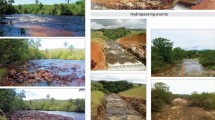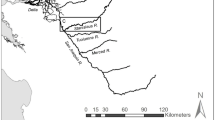Abstract
Government (Fisheries and Oceans Canada) and industry (Abitibi Consolidated Company of Canada) have been working cooperatively to protect and enhance wild Atlantic salmon populations on the Exploits River, insular Newfoundland, Canada. Since the mid-1960s, enhancement programmes and construction of fish passage facilities at natural and man-made barriers in the watershed have expanded the range and increased the returning adult population from 1200 fish (circa 1960) to 22,000 fish, on average. Since 1997, attention has been paid to improving passage and survival of downstream migrating smolts and kelts at two hydroelectric facilities at Grand Falls-Windsor and Bishops Falls. At Grand Falls-Windsor a floating louver and bypass system was installed in a power canal and extensive biological, hydraulic, and modelling studies have been conducted to assess, modify, and optimize fish passage. At Bishops Falls, a retrofitted surface spill bypass system was installed in an existing spill gate and similar studies have been conducted to improve passage success. Studies have also been conducted on the upstream migrating adults at these facilities and associated fishways, using conventional and physiological telemetry, to assess tailrace attraction and residency, and the relative energy cost of upstream migration to bypass the hydro plants and fishways. This article reviews the results of these various studies to demonstrate how cooperative work has improved passage of anadromous salmon in coexistence with hydroelectric development.








Similar content being viewed by others
References
Adams, N. S., D. W. Rondonf, S.D Evans, J. E. Kelly & R. W. Perry, 1998. Effects of surgically and gastrically implanted radio transmitters on swimming performance and predator avoidance of juvenile chinook salmon (Oncorhynchus tshawytscha). Canadian Journal of Fisheries and Aquatic Sciences 55: 781–787.
Bates, D. W. & R. Vinsonhaler, 1957. Use of louvers for guiding fish. Transactions of the American Fisheries Society 86: 38–57.
Bernatchez, L. & J. J. Dodson, 1987. Relationship between bioenergetics and behaviour in anadromous fish migrations. Canadian Journal of Fisheries and Aquatic Sciences 44: 399–407.
Booth, R. K., E. B. Bombardier, R. S. McKinley, D. A. Scruton, & R. F. Goosney, 1997. Swimming performance of post spawning adult (kelts) and juvenile (smolts) Atlantic salmon, Salmo salar. Canadian Manuscript Report of Fisheries and Aquatic Sciences 2406: v + 18 pp.
Bourgeois, C. E., 2003. A comparison of Atlantic salmon returns to the lower and middle Exploits River. Canadian Scientific Advisory Secretariat Research Document 2003/003: 1–14.
Clay, C. H., 1995. Design of Fishways and Other Fish Facilities. Lewis Publishers, Boca Raton, FL.
Cooke, S. J., E. B. Thorstad & S. G. Hinch, 2004. Activity and energetics of free-swimming fish: insights from electromyogram telemetry. Fish and Fisheries 5: 21–52.
Coutant, C. C., 1999. Think like a fish! Emphasizing the ‘behaviour’ in behavioural guidance systems. Hydro Review XVII: 18–24.
Duscharme, L. J. A., 1972. An application of louver deflectors for guiding Atlantic salmon (Salmo salar) smolts from power turbines. Journal of the Fisheries Research Board of Canada. 29: 1397–1404.
Electric Power Research Institute (EPRI), 1986. Assessment of Downstream Migrant Fish Protection Technologies for Hydroelectric Application. Electric Power Research Institute, EPRI AP-4711, Palo Alto, CA.
Federal Energy Regulatory Commission (FERC), 1995. Impacts of hydroelectric plant tailraces on fish passage: A report on effects of tailraces on migratory fish and use of barriers, modified project operation, and spills for reducing impacts. Paper DPR-9, Federal Energy Regulatory Commission, Office of Hydropower Licensing, Washington, DC.
Fleming, D. F. & J. B. Reynolds, 1991. Effects of spawning-run delay on spawning migration of arctic grayling. American Fisheries Society Symposium 10: 299–305.
Gowans, A. R. D., J. D. Armstrong & I. G. Priede, 1999. Movements of adult Atlantic salmon in relation to a hydroelectric dam and fish ladder. Journal of Fish Biology 54: 713–726.
Gowans, A. R. D., J. D. Armstrong, I. G. Priede & S. Mckelvey, 2003. Movement of Atlantic salmon migrating upstream through a fish-pass complex in Scotland. Ecology of Freshwater Fish 12: 177–189.
Haro, A., M. Odeh, J. Noreika & T. Castro-Santos, 1998. Effect of water acceleration on downstream migratory behaviour and passage of Atlantic salmon smolts and juvenile American shad at surface bypasses. Transactions of the American Fisheries Society 127: 118–127.
Hinch, S. G. & J. Brattey, 2000. Effects of swim speed and activity pattern on success of adult sockeye salmon migration through and area of difficult passage. Transactions of the American Fisheries Society 129: 598–606.
Hinch, S. G. & P. S. Rand, 1998. Swim speeds and energy use of upriver-migrating sockeye salmon (Oncorhynchus nerka): role of local environment and fish characteristics. Canadian Journal of Fisheries and Aquatic Sciences 55: 1821–1831.
Hinch, S. G., E. M. Standen, M. C. Healy & A. P. Farrell, 2002. Swimming patterns and behaviour of upriver-migrating adult pink (Oncorhynchus gorbuscha) and sockeye (O. nerka) salmon as assessed by EMG telemetry in the Fraser River, British Columbia, Canada. Hydrobiologia 483: 147–160.
Hvidsten, N. A. & B. O. Johnsen, 1997. Screening of descending Atlantic salmon (Salmo salar L.) smolts from hydropower intakes in the River Orkla, Norway. Nordic Journal of Freshwater Research 73: 44–49.
Larinier, M., 2001. Environmental issues, dams, and migration. In Marmulla G. (ed.), Dams, Fish, and Fisheries: Opportunities, Challenges and Conflict Resolution. Food and Agriculture Organization of the United Nations, Rome, 45–90.
Lucas, M. C. & E. Baras, 2001. Migration of Freshwater Fishes. Blackwell Sciences Ltd., London.
McCormick, S. D., L. P. Hansen, T. P. Quinn & R. L. Saunders, 1998. Movement, migration, and smolting of Atlantic salmon (Salmo salar). Canadian Journal of Fisheries and Aquatic Sciences 55: 77–92.
Moore, A., I. C. Russell & E. C. E. Potter, 1990. The effects of intreperitoneally implanted dummy acoustic transmitters on the behaviour and physiology of juvenile Atlantic salmon, (Salmo Salar L.). Journal of Fish Biology 37: 713–721.
Mullins, C. C., C. E. Bourgeois & T. R. Porter, 2003. Opening up new habitat: Atlantic salmon (Salmo salar L.) enhancement in Newfoundland. In Mills D. (ed.), Salmon at the Edge. Blackwell Science Ltd., Oxford, 200–221.
O’Connell, M. F. & C. E. Bourgeois, 1987. Atlantic salmon (Salmo salar L.) enhancement of the Exploits River, Newfoundland, 1957–1984. North American Journal of Fishery Management 7: 207–214.
O’Connell, M. F., J. B. Dempson, C. C. Mullins, D. G. Reddin, C. E. Bourgeois, T. R. Porter, N. M. Cochrane & D. Caines, 2003. Status of Atlantic Salmon (Salmo salar L.) Stocks of Insular Newfoundland (SFAs 3–14A), 2002. Canadian Scientific Advisory Secretariat Research Document 2003/002: 1–60.
Porter, T. R., 1975. Biology of Atlantic salmon in Newfoundland and Labrador. Fisheries and Marine Service. Newfoundland Region. Resource Development Branch. Information Report Series, NEW/N: 75–2: iv + 11 p.
Ruggles, C. P., 1980. A review of the downstream migration of Atlantic salmon. Canadian Technical Report of Fisheries and Aquatic Sciences 952: 39.
Ruggles, C. P. & D. G. Murray, 1983. A review of fish response to spillways. Canadian Technical Report of Fisheries and Aquatic Sciences 1172: 31.
Ruggles, C. P. & P. Ryan, 1964. An investigation of louvers as a method of guiding juvenile Pacific salmon. Canadian Fish Culturist 33: 3–67.
Ruggles, C. P., D. A. Robinson & R. J. Stira, 1993. The use of floating louvers for guiding Atlantic salmon smolts from hydroelectric turbine intakes. In Williams, U. P., D. A. Scruton, R. F. Goosney, C. E. Bourgeois, D. C. Orr & C. P. Ruggles (eds), Proceedings of the Workshop on Fish Passage at Hydroelectric Developments. Canadian Technical Report of Fisheries and Aquatic Sciences 1905, 87–94.
Scruton, D. A., R. S. McKinley, N. Kouwen, W. Eddy & R. K. Booth, 2002. Use of telemetry and hydraulic modeling to evaluate and improve fish guidance efficiency at a louver and bypass system for downstream-migrating Atlantic salmon (Salmo salar) smolts and kelts. Hydrobiologia 483: 83–94.
Scruton, D. A., C. J. Pennell, L. M. N. Ollerhead, K. D. Clarke, R. K. Booth, F. Cubitt & R. S. McKinley, 2004a. Conventional and EMG telemetry studies of the tailrace attraction of upstream migrating adult Atlantic salmon at a hydroelectric installation on the Exploits River, Newfoundland, Canada. In Garcia de Jalon Lastra, D. & P. Vizcaino Martinez (eds), Fifth International Conference on Ecohydraulics. Aquatic Habitats: Analysis and Restoration. IAHR Congress Proceedings, Vol. II, Madrid, Spain, 1014–1019.
Scruton, D. A., C. J. Pennell, R. F. Goosney, C. E. Bourgeois, T. R. Porter, & K. D. Clarke, 2004b. Initial assessment of a retrofitted downstream fish bypass system for wild Atlantic salmon (Salmo salar) smolts on the Exploits River, Newfoundland, Canada. In Garcia de Jalon Lastra, D. & P. Vizcaino Martinez (eds), Fifth International Conference on Ecohydraulics. Aquatic Habitats: Analysis and Restoration. IAHR Congress Proceedings, Vol. II. Madrid, Spain, 1026–1030.
Scruton D. A., C. J. Pennell, M. J. Robertson, K. D. Clarke, W. Eddy & R. S. McKinley, 2004c. Telemetry studies of the passage route and entrainment of downstream migrating wild Atlantic salmon (Salmo salar) smolts at two hydroelectric installations on the Exploits River, Newfoundland, Canada. In Spedicato M. T., G. Lembo & G. Marmulla (eds), Aquatic Telemetry: Advances and Applications. Fisheries and Agriculture Organization/COISPA Technology and Research, Rome, Italy, 91–101.
Smith, I. P., A. D. F. Johnstone & G. W. Smith, 1997. Upstream migration of adult Atlantic salmon past a fish counter weir in the Aberdeenshire Dee, Scotland. Journal of Fish Biology 51: 266–274.
Standen, E. M., S. G. Hinch, M. C. Healey & A.P Farrell, 2002. Energetics costs of migration through the Fraser River Canyon, British Columbia, in adult pink (Oncorhynchus gorbuscha) and sockeye (Oncorhynchus nerka) salmon as assessed by EMG telemetry. Canadian Journal of Fisheries and Aquatic Sciences 59: 1809–1818.
Taylor, V. R. & B. R. Bauld, 1973. A program for increased Atlantic salmon (Salmo salar) production on a major Newfoundland River. International Atlantic Salmon Foundation Special Publication Series 4: 339–347.
Thorstad, E. B., F. Okland, F. Kroglund & N. Jepsen, 2003. Upstream migration of Atlantic salmon at a power station on the River Nidelva, southern Norway. Fisheries Management and Ecology 10: 139–146.
U.S. Congress, Office of Technologies Assessment, 1995. Fish Passage Technologies: Protection at Hydropower Facilities. United States Government Printing Office, OTA-ENV-641, Washington, DC.
Ward, J. V., 1989. The 4-dimensional nature of lotic systems. Journal of the North American Benthicological Society 8: 2–8.
Williams. U. P., D. A. Scruton, R. F. Goosney, C. E. Bourgeois, C. P. Ruggles & D. C. Orr, 1993. Proceedings of the Workshop on Fish Passage at Hydroelectric Developments. Canadian Technical Report of Fisheries and Aquatic Sciences 1905: v + 153 p.
Winstone, A. J., A. S. Gee & P. V. Varallo, 1985. The assessment of flow characteristics at certain weirs in relation to the upstream movements of migratory salmonids. Journal of Fish Biology 27: 75–83.
Winter J. D., 1983. Underwater biotelemetry. In: Nielsen L. A. & D. L. Johnson (eds), Fisheries Techniques. American Fisheries Society, Bethesda, MD: 371–395.
Author information
Authors and Affiliations
Corresponding author
Additional information
Guest editors: R. L. Welcomme & G. Marmulla
Hydropower, Flood Control and Water Abstraction: Implications for Fish and Fisheries
Rights and permissions
About this article
Cite this article
Scruton, D.A., Pennell, C.J., Bourgeois, C.E. et al. Hydroelectricity and fish: a synopsis of comprehensive studies of upstream and downstream passage of anadromous wild Atlantic salmon, Salmo salar, on the Exploits River, Canada. Hydrobiologia 609, 225–239 (2008). https://doi.org/10.1007/s10750-008-9410-4
Published:
Issue Date:
DOI: https://doi.org/10.1007/s10750-008-9410-4




